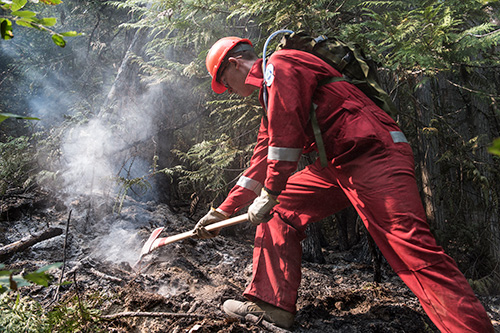Exertional Heat Illness (EHI) – Supervisor Guidance
July 14, 2025 – Defence Stories
Estimated read time – 2:30
Author: Directorate of Force Health Protection
As temperatures rise, supervisors must take proactive steps to manage heat stress among personnel and reduce the risk of Exertional Heat Illness (EHI) during activities. Prevention is far easier than treatment.
High-Risk Activities: The 4 E’s

Caption
Soldiers from 1st Battalion, Princess Patricia’s Canadian Light Infantry and 39 Canadian Brigade Group search for and extinguish hot spots and burning material in a fire affected area near Lumby, British Columbia during Operation LENTUS, August 23, 2018.
Photo: MCpl Gerald Cormier, 3rd Cdn Div Public Affairs
Activities are more likely to lead to EHI if they involve one or more of the following:
- Effort: Intense physical exertion or carrying heavy loads, especially for extended periods.
- Environment: High temperatures and humidity.
- Ensemble: Wearing kit that insulates the body and restricts airflow.
- Exceptional: Personal or medical risk factors such as:
- Low fitness
- Lack of heat acclimatization
- Inadequate hydration or nutrition
- Recent illness
- Certain medications or medical conditions (e.g., prior heat illness).
Understanding Heat Buildup
Heat from physical activity and the environment accumulates in the body, especially when kit and humidity limit cooling. Core body temperature can continue to rise even after activity stops, only declining five or more minutes post-exertion.
Types of Exertional Heat Illness
- Heat Exhaustion: Overwhelming heat strain with symptoms like fatigue and nausea. Recovery is quick with rest, cooling, and hydration.
- Heat Injury: Overheating causes damage to vital organs. Recovery may be incomplete and could require organ transplantation or result in death in extreme cases.
- Heat Stroke: The brain overheats, potentially causing permanent disability or death in severe cases.
Recognizing EHI – When to Call for Help
Watch for these symptoms:
- Fatigue, weakness, or malaise
- Muscle cramps
- Dizziness or difficulty walking/standing
- Headache
- Nausea, vomiting, or loss of bladder/bowel control
- Slurred or slow speech
- Confusion, irritability, combativeness, seizures, or unconsciousness.
If any of these are seen, personnel should immediately call for emergency medical help.
Immediate Actions to Take
- Move the person to shade and assess responsiveness by asking:
- What is your name?
- What month and year is it?
- Where are you?
- What were you doing before you became ill?
- Check ABCs (Airway, Breathing, Circulation). Provide CPR if needed.
- Remove excess clothing/kit and begin cooling using the safest and most effective method available. Do not wait for emergency medical personnel before starting cooling.
Rapid Cooling Saves Lives
Every minute counts. Cooling within 30–60 minutes can limit organ damage, improve recovery chances, and prevent death.
Preparation Tips
- Pre-position coolers with ice sheets before high-risk activities, and have an evacuation plan in place.
Ice-Sheeting Method
- Fill a cooler: ⅔ ice, ⅓ cold water.
- Soak 6 sheets in the mixture.
- Apply sheets to:
- Groin
- Armpits
- Neck/head
- Entire body (one sheet)
- Repeat every 3 minutes.
Preventing Exertional Heat Illness requires proactive planning, early recognition of symptoms, and immediate intervention. Unfortunately, the CAF reports multiple cases annually, including fatalities in recent years. This life-threatening but preventable condition demands urgent action from supervisors to safeguard personnel and save lives.